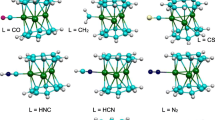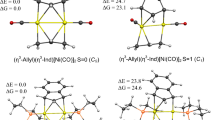Abstract
Structure-related DFT calculations for IIIA metal tripivalates [M(piv)3] (M = Al, Ga, In, Tl) were performed. On the potential energy hypersurface (PES) for the Al, Ga, In, and Tl complexes, only a molecular structure of C 3 symmetry based on a distortion of an antiprismatic MO6 coordination polyhedron is found as a minimum. The geometry of C 3v symmetry corresponds to the first-order saddle points on the PES. The analysis of internal rotation of the tert-butyl groups and plane chelate ring in pivalate molecules was performed also. The structural flexibility within the coordination polyhedron MO6 was found to increase along the series Al → Ga → In → Tl. According to the analyses of the electron density distribution (NBO and QTAIM), the central atom M has no appreciable effect on the geometry of the peripheral tert-butyl groups, so that the most significant differences occur in the coordination polyhedron MO6. The lengthening of the M–O bond and decreasing of the binding energy are correlated with the ionic radius of the metal atom M. This fact proves the ionic binding nature of the title molecules. Appropriate assignment of vibrational modes was carried out by usage of the potential energy distribution analysis among internal coordinates.







Similar content being viewed by others
References
Eley DD, Hazeldine DJ, Palmer TF (1973) Mass spectra, ionization potentials and related properties of metal-free and transition metal phthalocyanines. J Chem Soc Faraday Trans 2 Mol Chem Phys 69:1808
Finazzo C, Calle C, Stoll S, Van Doorslaer S, Schweigery A (2006) Matrix effects on copper(II)phthalocyanine complexes. A combined continuous wave and pulse EPR and DFT study. Phys Chem Chem Phys 8:1942–1953
Zhuravlev KP, Yakovlev YO (2005) Fizika tverdova tella (Russian) 47(8):1518–1521
Bloor LG, Carmalt CJ, Pugh D (2011). Coord Chem Rev 255:1293–1318
Kamkin NN, Kayumova DB, Yaryshev NG, Dementiev AI, Malkerova IP, Alikhanyan AS (2012) Synthesis and thermodynamic characteristics of aluminum, gallium, and indium pivalates. Russ J Inorg Chem 57(10):1308–1312
Kamkin NN, Kuz’mina LG, Kayumova DB, Yaryshev NG, Dementiev IA, Alikhanyan AS (2012) Synthesis and thermodynamic and structural characteristics of thallium(I) pivalate. Russ J Inorg Chem 57(9):1267–1271
Belova NV, Dalhus B, Girichev GV, Giricheva NI, Haaland A, Kuzmina NP, Zhukova TA (2011) Struct Chem 22:393–399
Girichev GV, Giricheva NI, Zhukova TA, Kuzmina NP (2011) Izv Vysh Uchebn Zaved Khim Khim Technol (Russian) 54
Belova NV, Girichev GV, Haaland A, Zhukova TA, Kuzmina NP (2013) The molecular structure of tris-2,2,6,6-tetramethyl-heptane-3,5-dione indium: gas-phase electron diffraction and quantum chemical calculations. Struct Chem 24:901–908
Frisch MJ, Trucks GW, Schlegel HB, Scuseria GE, Robb MA, Cheeseman JR, Montgomery JA, Vreven JT, Kudin KN, Burant JC, Millam JM, Iyengar SS, Tomasi J, Barone V, Mennucci B, Cossi M, Scalmani G, Rega N, Petersson GA, Nakatsuji H, Hada M, Ehara M, Toyota K, Fukuda R, Hasegawa J, Ishida M, Nakajima T, Honda Y, Kitao O, Nakai H, Klene M, Li X, Knox JE, Hratchian HP, Cross JB, Adamo C, Jaramillo J, Gomperts R, Stratmann RE, Yazyev O, Austin AJ, Cammi R, Pomelli C, Ochterski JW, Ayala PY, Morokuma K, Voth GA, Salvador P, Dannenberg JJ, Zakrzewski VG, Dapprich S, Daniels AD, Strain MC, Farkas O, Malick DK, Rabuck AD, Raghavachari K, Foresman JB, Ortiz JV, Cui Q, Baboul AG, Clifford S, Cioslowski J, Stefanov BB, Liu G, Liashenko A, Piskorz P, Komaromi I, Martin RL, Fox DJ, Keith T, Al-Laham MA, Peng CY, Nanayakkara A, Challacombe M, Gill PMW, Johnson B, Chen W, Wong MW, Gonzalez C, Pople JA (2003) Gaussian 03, Revision B.03. Gaussian, Inc Pittsburgh PA
Becke AD (1988) Density-functional exchange-energy approximation with correct asymptotic behavior. Phys Rev A 38:3098
Becke AD (1993) Density-functional thermochemistry. III. The role of exact exchange. J Chem Phys 98:5648–5652
Lee C, Yang W, Parr RG (1988) Phys Rev B 37:785–789
Igel-Mann G, Stoll H, Preuss H (1988) Mol Phys 65:1321–1328
Metz B, Stoll H, Dolg M (2000) J Chem Phys 113:2563–2569
Metz B, Schweizer M, Stoll H, Dolg M, Liu W (2000) Theor Chem Acc 104:22–28
Poppe J (Unpublished work)
Igel-Mann G (1988) (Unpublished work)
Peterson KA (2003) J Chem Phys 119:11099–111112
Woon DE, Dunning TH (1993) Gaussian basis sets for use in correlated molecular calculations. III. The atoms aluminum through argon. J Chem Phys 98(2):1358–1371. doi:10.1063/1.464303
Godbout N, Salahub DR, Andzelm J, Wimmer E (1992) Optimization of Gaussian-type basis sets for local spin density functional calculations. Part I. Boron through neon, optimization technique and validation. Can J Chem 70(2):560–571. doi:10.1139/v92-079
Sosa C, Andzelm J, Elkin BC, Wimmer E, Dobbs KD, Dixon DA (1992) A local density functional study of the structure and vibrational frequencies of molecular transition-metal compounds. J Phys Chem 96(16):6630–6636. doi:10.1021/j100195a022
Carpenter JE, Weinhold F (1988) J Mol Struct (Theochem) 169:41–62
Zhurko GA, Zhurko DA ChemCraft version 1.6 (build 312); version 1.6 (build 312) ed. http://www.chemcraftprog.com/index.html
Bader RFW (1990) Atoms in molecules—a quantum theory. Oxford University Press, Oxford
Todd A. Keith (2014) AIMAll (Version 13.01.27)
Sipachev VA (1985) Calculation of shrinkage corrections in harmonic approximation. J Mol Struct (Theochem) 121(1–2):143–151
Sipachev VA (1999) Vibrational effects in diffraction and microwave experiments: a start on the problem. In: Hargittai I, Hargittai M (eds) Advanced in molecular structure research, vol 5. JAI Press, New York, pp 263–311
Sipachev VA (2001) Local centrifugal distortions caused by internal motions of molecules. J Mol Struct 567–568:67–72
Blatov VA, Proserpio DM (2013) TOPOS version 4.0. http://www.topos.samsu.ru
Belova NV, Sliznev VV, Zhukova TA, Girichev GV (2011) Molecular structure and intramolecular rearrangements in tris-2,2,6,6-tetramethyl-heptane-3,5-dione complexes, M(thd)3 (M = B, Al, Ga, In, Tl) by DFT calculations. Comput Theor Chem 967:199–205
Wiberg KB (1968) Application of the pople–santry–segal CNDO method to the cyclopropylcarbinyl and cyclobutyl cation and to bicyclobutane. Tetrahedron 24(3):1083–1096. doi:10.1016/0040-4020(68)88057-3
Waber JT, Cromer DT (1965) Orbital radii of atoms and ions. J Chem Phys 42(12):4116–4123
Perrin CL (1991) Atomic size dependence of Bader electron populations: significance for questions of resonance stabilization. J Am Chem Soc 113:2865–2868
Krasnov KS (ed) (1979) Molecular constants of inorganic compounds. Handbook (Russian). Khimiya, Leningrad
Glushko VP (ed) (1971) The thermal constants of materials. Handbook (Russian). VINITI Moscow
Collaboration: Scientific Group Thermodata Europe (SGTE). SpringerMaterials: The Landolt-Bornstein Database. Group IV Physical Chemistry (1999)
Acknowledgments
This work was supported by the Russian Foundation for Basic Research (Grant No. 14-03-31784mol_a) the Deutsche Forschungsgemeinschaft (core facility GED@BI, Grant Mi477/21-1) and the “Regionales Rechenzentrum der Universität zu Köln (RRZK)” by providing the necessary computational resources. O. A. Pimenov thanks the Ministry of Education and Science of the Russian Federation (Project 11.9192.2014) and German academic exchange service DAAD (Project A/13/75242) for financial support. Yu. A. Zhabanov thanks the Ministry of Education and Science of the Russian Federation (Project 11.9166.2014) and German academic exchange service DAAD (Project A/13/75239) for financial support. Authors also thank Prof. N. V. Belova, Dr. V.V. Sliznev, and Prof. N. W. Mitzel for their constructive suggestions.
Author information
Authors and Affiliations
Corresponding author
Additional information
Dedicated to Prof. Magdolna Hargittai on the Occasion of her 70th birthday.
Electronic supplementary material
Below is the link to the electronic supplementary material.
Rights and permissions
About this article
Cite this article
Pimenov, O.A., Zhabanov, Y.A., Pogonin, A.E. et al. Structure and energetical properties of metal pivalate chelates M(piv)3 (M = Al, Ga, In, Tl) by DFT calculations. Struct Chem 26, 1443–1450 (2015). https://doi.org/10.1007/s11224-015-0639-z
Received:
Accepted:
Published:
Issue Date:
DOI: https://doi.org/10.1007/s11224-015-0639-z




